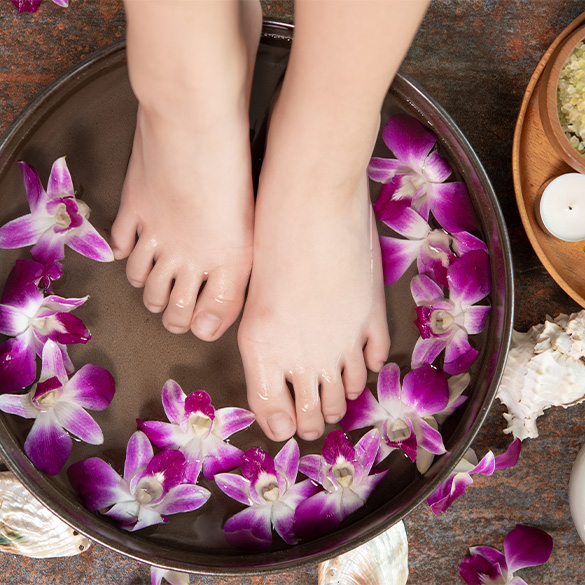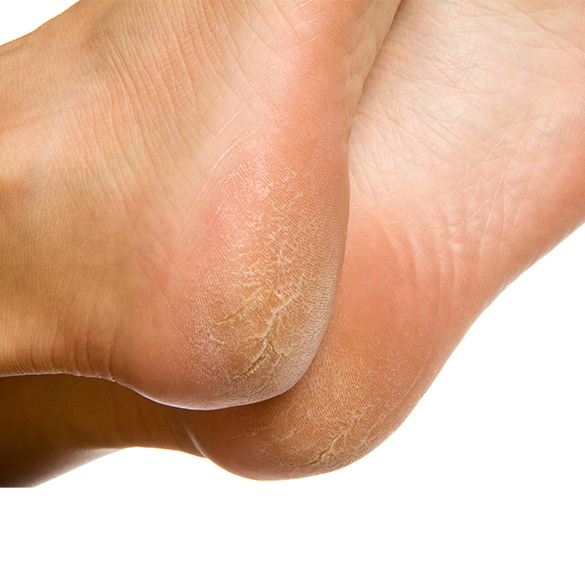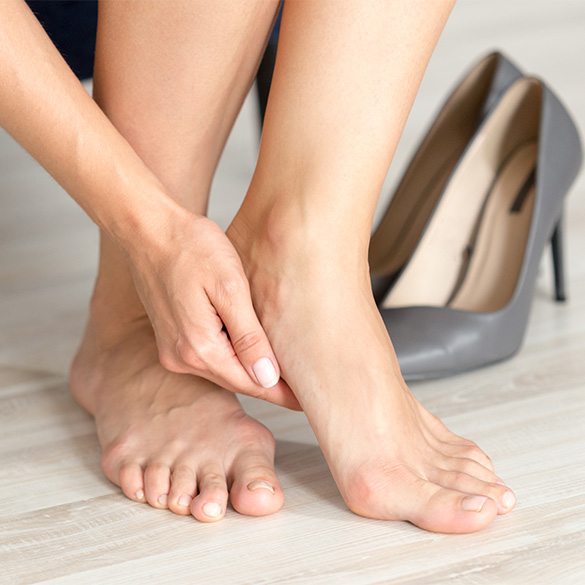
Receive A
FREE GIFT
When you sign up for text messages
08/08/23
Notice dry, flakey peeling skin on your feet lately? Or maybe it's a recurring problem that you can't quite seem to solve? In either case, you're not alone, as plenty of people all over the globe suffer from peeling skin on the feet.
But why do your feet peel? Well, there are quite a few possible explanations, and peeling feet can be caused by a range of skin conditions. In this guide, we'll cover all you need to know about peeling feet and how you can treat them.
The skin on the soles of your feet has to deal with some pretty harsh conditions. Socks and shoes can irritate it, and your feet can also come into contact with a range of dirty surfaces, rough ground, and changing temperatures, even while walking around your own home.
Therefore, it's quite natural for this skin to have issues, like hardening, cracking, dryness, and peeling, too. But feet peeling isn't only caused by simple day-to-day wear and tear on your soles; it can be a symptom of various skin conditions.
So, before we look at what you can do to deal with peeling skin on your feet, let's examine some of the many possible causes of this common problem.
One of the most common causes of dead skin on feet peeling away is athlete’s foot. Athlete's foot is a fungal infection which affects the feet, in particular, and it's quite common in athletes or very active people who do a lot of sport and physical activity, which is where the name comes from.

With athlete's foot, a fungus begins to grow, usually in the spaces between the toes. This can result in redness, itchiness, and the appearance of a painful, peeling rash on the skin. Other symptoms may even include blistering and burning sensations in the feet.
How does athlete's foot happen? Well, since it's a fungal problem, people can catch this condition by coming into contact with the fungus itself. And if you spend a lot of time in places like locker rooms and gyms, you're more likely to encounter the fungus and catch athlete's foot yourself. This is why it’s wise to avoid walking in bare feet in those kinds of environments.
SolutionEven though athlete's foot can be a painful and unpleasant condition, it is treatable. Various antifungal medications exist to remove the fungus, and it's possible for athlete's foot to clear up quite quickly, with the right medication.
You can also reduce your risk of catching athlete's foot in the first place by wearing shoes or sandals in public places, keeping your feet cool and dry as much as possible, and never sharing socks, sneakers, or towels with other people.
Another very common cause of peeling skin on the feet is simply dry skin. A lot of people naturally struggle with dry skin due to their genetics, and it's possible to develop dry skin if you have certain habits, like failing to moisturize your body, not drinking enough water, spending lots of time in the sun, or taking very hot showers.
SolutionSo, what can be done about dry, peeling skin on the feet? Well, the right skincare products, like hydrating foot masks, can make a big difference. Using moisturizer on your feet is also recommended, and you can make the air in your home wetter with the aid of a humidifier, as well as drinking plenty of water daily.

Eczema is one of the most common skin conditions, affecting millions of people worldwide. It can occur all over the body, including on the feet, and it causes skin to feel dry, itchy, cracked, and peeling. It may also lead to infections and redness.
Scientists aren't sure exactly what causes eczema, although it is believed to be linked to both genetics and environmental factors, and people with allergies have been shown to be more likely to develop this condition.
SolutionIf you have eczema on your feet, you can use various medications to soothe the symptoms. Topical creams and lotions can help to ease any itching and dryness, while antihistamines may also help to lessen the symptoms. There are also some other possible treatments for more serious cases, like light therapy or steroids.
Bonus Solution: To help soothe the itchy and dry effects of eczema on your body and not just your feet, we recommend regular application of our Body Refining Exfoliant to help uncover smoother, softer, more radiant-looking skin.
Like eczema, psoriasis is a common skin condition. It causes scaly patches of red skin to appear on the body, and symptoms may include itchiness and pain in the affected areas. Psoriasis can appear all over the body, and it's quite common for it to flare up on the soles of the feet.
Like eczema, scientists aren't entirely sure about the causes or origins of psoriasis, but it is believed to be associated with genes and is classified as an immune condition. There's not a lot that can be done to 'cure' this problem, but there are ways to keep it under control.
SolutionPsoriasis dead skin on feet peeling is often triggered by certain conditions, like cold weather, stress, or even after drinking alcoholic beverages. Sufferers are encouraged to learn their triggers and try to avoid them as much as possible.
You can also make use of various treatments to soothe the symptoms of psoriasis, including topical corticosteroid creams, as well as moisturizing lotions and possibly even immunosuppressant pills to control the body’s immune responses.
Another possible answer to 'Why do your feet peel?' is that you might be suffering from hyperhidrosis. Hyperhidrosis is a condition that makes people sweat very large amounts. It may occur all over the body, or can be focused in certain key areas, and the feet tend to suffer a lot from the excess production of sweat.
SolutionThere are various medical treatments that can be used to deal with this condition, including prescription solutions that can be used on the parts of the body that tend to sweat the most in order to reduce the levels of sweat production in those places. Anticholinergic drugs may also be prescribed, and it’s vital to see a doctor for a proper assessment and prescription.
As we can see, there are quite a few possible answers to ‘Why do your feet peel?’ and some of the conditions involved are quite serious, while others are less worrisome, but still frustrating for people to deal with.
For the more serious conditions, the only real solutions are relevant prescription and over-the-counter medications, as advised by a physician or dermatologist.
However, for the milder causes of dead skin on the feet, you may be able to make use of hydrating skincare solutions. Foot peels and rejuvenating foot masks can be of great use to bring life back to dull, dried out, and peeling feet, helping the skin become smoother and healthier once again.
How often can you do a foot peel? Experts recommend doing a foot peel every six to eight weeks, on average. This is ideal for getting rid of the dead and peeling skin, once and for all, letting the fresh, new skin cells underneath have time to breathe and grow.

As for foot masks, it’s best to do them around once a month. Foot masks are excellent for soothing the skin and providing vital nourishment and hydration that the skin of the feet regularly needs.

So, if you’re suffering from a serious condition, like hyperhidrosis or athlete’s foot, make sure to get the medical help you need. But if your feet are peeling due to something more minor, like dry skin or too many hot showers, using feet peels and masks could make a huge difference. Try Crepe Erase’s Renew & Smooth Hydrating Foot Mask or Renew & Smooth Foot Peel to give your feet the care they need.